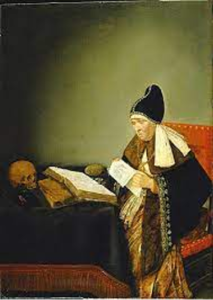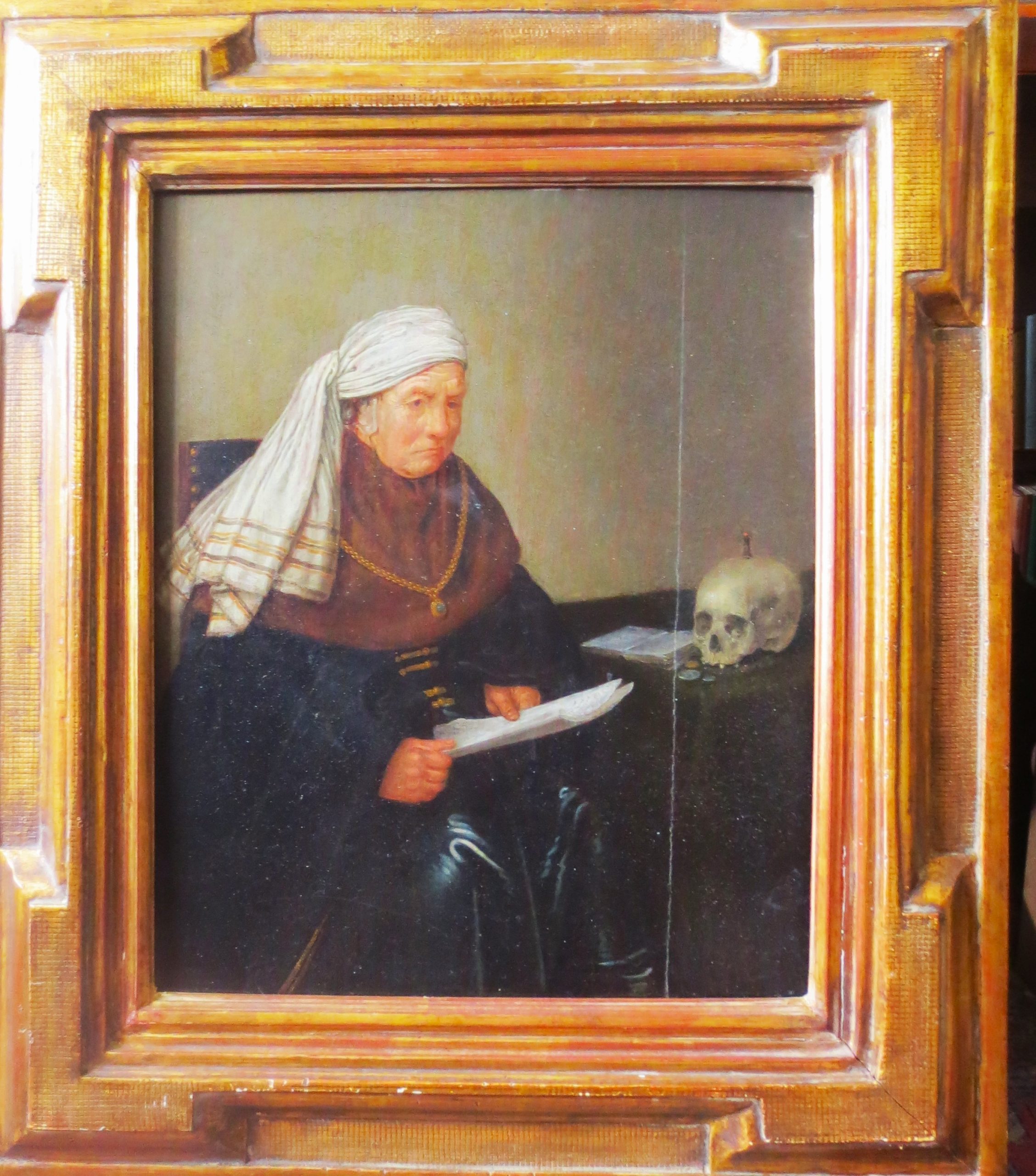Still known only by his signatory initials, the Monogrammist I.S. is credited with a group of monogrammed or soundly attributed paintings executed in an archaizing style of precisely detailed painting – fijn schilderij – as initiated by Jan van Eyck a century earlier and forwarded through Rembrandt’s early para-Eyckian realism to a circle of younger artists in Leiden and then Amsterdam. Within that chosen form of hyper-realism, the Monogrammist I.S. produced for about twenty-five years from the early 1630s to the later 1650s a small but coherent oeuvre primarily of single figures and tronies informed by a small repertoire of vanitas signs and symbols including in varying combinations elderly models reading or in meditative stillness, archaizing or pseudo-Burgundian dress, and a standard trio of old books, a skull and an extinguished candle, all symbols of transient vanities and prescriptions for the devout ars moriendi.
Within the small known oeuvre of the Monogrammist I.S. these para-Eyckian, Rembrandtesque moralities form a distinct core group to which the present previously unpublished painting may be added. Even shorn of its probable original signature, the iconography and style of this painting is completely consonant with several other unquestionable works by the Monogrammist I.S. that also include motifs of an old book and scattered coins, a burnt candle and a skull, and a gold chain as a sign of Burgundian rank. These related paintings include:
An Old woman Reading a Letter in the Stockholm National Museum, monogrammed and dated 1658, oil on panel: 19 ½ x 13 ½ in/50 x 35 cm; cf. Bernt, Netherlandish Painters, s.v.; Sumowski, Gemälde der Rembrandt-Schűler, IV, 2550, n.27.

Here are the combined vanitas signs of gold coins, old books, a skull, and gold chain with medallion, close cousins of the same items in the present painting. Further, the scowling elderly faces of both subjects are much alike in hard features and patterns of wrinkles. In both the Stockholm and present painting, the subject’s hands both painted with a telling stiffness of parallel fingers and unbending line of the knuckles, which in turn are individually modeled with isolating emphasis.
2. AYoung Student at Study Table in Munich includes a skull and burnt candle, elements of the same repertoire of vanitas signs rendered with similar chiaroscuro patterns and brush touch as in the present painting ; cf. Sumowski, Gemälde der Rembrandt-Schűler, IV, 2550, n. 12.
3. Old Man at Table with Vanitas Still-Life in Braunschweig also includes the pro forma candle and burnt wick and is again modeled with much the same level of precision and rapid touch as the present painting; cf. Sumowski, n.25.
4. A tronie of an Old Woman with Gold Chain and Medallion sold by Lempertz in Cologne seems close enough in type and handling to suggest a date towards mid-century that may well represent the same model and style as seen in the probably contemporary or only slightly earlier present painting.

With several other recent appearances in the auction rooms of paintings plausibly attributed to the Monogrammoist I.S. the core of the artist’s work is now large and consistent enough to confirm older suppositions and allow some further speculation about the artist. Albeit without positive proof of residence, the Monogrammist I.S. appears to have had some tangential affiliations with the circle of miniaturizing painters working in Leiden, Haarlem and Amsterdam under the pervasive influence of Rembrandt’s small earlier paintings. As products by Rembrandt’s hand, studio copyists and extramural imitators just before and soon after his relocation from Leiden to Amsterdam, this entourage by proxy with names or without, shared enough traits to form a collective artistic entity. Several actually had names with the same initials as the Monogrammist, but with differing minutiae of style.
Although this remarkable codification of much diverse and variable art remains essential albeit without any mention of the Monogrammist I.S. as a tangential outlier of the Dou orbit – much as Vrel would be to Vermeer, it permits a thought or two about this rare, elusive and fascinating smaller master. These paintings demonstrate the penetration of the Eyckian facet of Dutch tronies as developed in the Rembrandt school into a core gathering of moralizing images in an archaizing style that suggest the expression of religious concerns along the lines of the visionary Ars Moriendi otherwise engaged in a pulpit-oriented profession that was privately expressed in a style that, like its iconographic components, reflected an older conservative art in its revitalized stature around Rembrandt.
REFERENCES:
Werner Sumowski, Gemälde der Rembrandt-Schűler, IV, Landau, 1983, p.2550, notes 12 – 27 with further literature on all known at the time. This may be amplified cum grano salis by the near dozen un- or little known paintings at auction since Sumowski’s publication. For a fair share of the ongoing imitation of Rembrandt’s ‘little’ manner from Dou on, there is a great deal of essential information and illustration multum in parvo in the extensive taxonomic codification of much of this movement and its participants (save for the Monogrammist I.S.) in Erich Jan Sluiyter, Rembrandt’s Rivals, Amsterdam, 2015.

